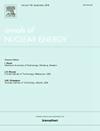Simulation of the effect of partial and total blockage in a subchannel on flow features distribution and interactions in sodium-cooled 5 × 5 rod bundles
IF 1.9
3区 工程技术
Q1 NUCLEAR SCIENCE & TECHNOLOGY
引用次数: 0
Abstract
Subchannel flow obstruction accident is one of the safety considerations for sodium-cooled fast reactors. A computational fluid dynamics simulation was performed to study the flow of liquid sodium in a 5 × 5 fuel assembly with partial and entire blockage of a sub-channel. A situation with no blockage was used as a baseline for further investigation into following cases with blockages. The effect of a 75 % and total obstruction in a subchannel on the flow characteristics and heat transfer in the fuel assembly was studied from −5 hydraulic diameters before the blockage to 50 hydraulic diameters after the blockage and compared. The temperature surge of 10 K due to flow through the spacer in the model without blockage increased to 14 K and 24 K in the models with partial obstruction and total blockage, respectively. The blockage-induced resistance coefficient, turbulence kinetic energy distribution, and temperature fluctuation in the adjacent subchannels can be monitored to detect the blockage.
求助全文
约1分钟内获得全文
求助全文
来源期刊

Annals of Nuclear Energy
工程技术-核科学技术
CiteScore
4.30
自引率
21.10%
发文量
632
审稿时长
7.3 months
期刊介绍:
Annals of Nuclear Energy provides an international medium for the communication of original research, ideas and developments in all areas of the field of nuclear energy science and technology. Its scope embraces nuclear fuel reserves, fuel cycles and cost, materials, processing, system and component technology (fission only), design and optimization, direct conversion of nuclear energy sources, environmental control, reactor physics, heat transfer and fluid dynamics, structural analysis, fuel management, future developments, nuclear fuel and safety, nuclear aerosol, neutron physics, computer technology (both software and hardware), risk assessment, radioactive waste disposal and reactor thermal hydraulics. Papers submitted to Annals need to demonstrate a clear link to nuclear power generation/nuclear engineering. Papers which deal with pure nuclear physics, pure health physics, imaging, or attenuation and shielding properties of concretes and various geological materials are not within the scope of the journal. Also, papers that deal with policy or economics are not within the scope of the journal.
 求助内容:
求助内容: 应助结果提醒方式:
应助结果提醒方式:


